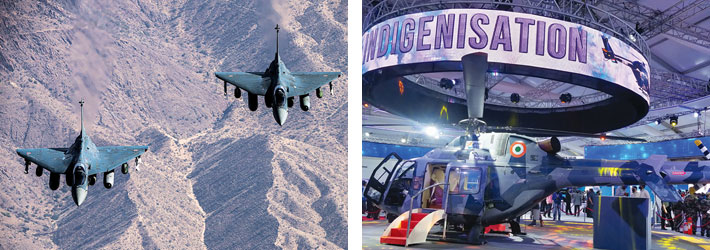- Prime Minister Narendra Modi inaugurates Aero India 2023 in Bengaluru; Releases Commemorative Stamp
- Defence Secretary meets delegations from Saudi Arabia, USA and Oman on the sidelines of Aero India 2023
- Foreign Ministers of 32 countries to attend Aero India 2023
- Embraer showcases the C-390 Millennium at Aero India 2023
India’s Aviation Technology Growth Strategy
In an effort to strengthen its aerospace industry, India has asked major weapon exporting countries to transfer technology to India, including manufacturing of critical aircraft components in the country

In November 2018, NITI Aayog released the ‘Strategy for New India @ 75’. It had identified 41 different areas that require either a sharper focus on implementing the flagship schemes already in place or a new design and initiative to achieve India’s true potential. Civil Aviation and Technology Innovation were one of them. The focus of the strategy is to improve the policy environment in which private investors and other stakeholders can contribute towards achieving the goals set out for clean, inclusive, sustained and sustainable growth for the next three decades.
INVESTMENT
According to the data released by Department for Promotion of Industry and Internal Trade (DPIIT), Foreign Direct Investment (FDI) inflow in India’s air transport sector reached $2.79 billion between April 2000 and June 2020. The government has allowed 100 per cent FDI under the automatic route in scheduled air transport service, regional air transport service and domestic scheduled passenger airline. However, FDI over 49 per cent would require government approval. India’s aviation industry is expected to witness 35,000 crore ($4.99 billion) investment in the next four years. The Indian Government is planning to invest $1.83 billion for development of airport infrastructure along with aviation navigation services by 2026.
GOVERNMENT INITIATIVES
Ude Desh ka Aam Nagrik (UDAN) has been instrumental in connecting travellers to destinations that were difficult to reach until now. The scheme focuses on providing connectivity to un-served and under-served airports of the country through the revival of existing airstrips and airports. The Government of India has ensured sustainability by raising the budget substantially for UDAN for the next 10 years.
NABH Nirman (NextGen Airports for Bharat) is an initiative to enhance airport capacity for handling one billion trips in the next 10 to 15 years. According to official sources, the government is also considering setting up a NABH Nirman Fund (NNF) with a starting corpus of around $2 billion to support low traffic airports in their initial phases. The Civil Aviation Ministry has prepared a proposal seeking additional funds for this flagship scheme by the Centre.
The Airports Authority of India (AAI) that runs all the non-private civilian airports in the country, has plans to create additional capacity in the airports at Agartala, Patna, Srinagar, Pune, Trichy, Vijayawada, Port Blair, Jaipur, Mangalore, Dehradun, Jabalpur, Kolhapur, Goa, Rupsi, Leh, Calicut, Imphal, Varanasi and Bhubaneswar, with a capital expenditure of 20,178 crore over the next four to five years. AAI has also decided to lease out six airports run by them, Ahmedabad, Jaipur, Lucknow, Guwahati, Thiruvanthapuram and Mangaluru under phase 1 of development, operation and management under PPP.
The government’s focus is also on developing an aircraft financing and leasing model in the country and leveraging the country’s large engineering pool to develop a hub for maintenance, repair and overhaul (MRO) services and thereby achieve self-reliance in aircraft maintenance and engineering services.
The government of India has recognised the potential of Artificial Intelligence (AI) and believes that it can boost the country’s GDP with $957 billion by 2035. NITI Aayog is working on the national strategy on Artificial Intelligence and proposed an investment of 7,500 crore in funding five institutes or centres for research excellence, 20 international centres for transformational AI for research, development, adoption and skilling in AI.
DEFENCE
The aviation industry which includes military and civil aviation is regarded as strategic. Defence indigenous technologies will have to be developed especially when this is not available from other countries. It is an industry that involves one of the largest varieties of technologies and number of components/assemblies and equipment. Spin offs into a broad and varied range of industrial sectors is possible. Technology up-gradation for self-sufficiency in various fields has to be an ongoing and vigorous process. Government needs to aggressively encourage and fund Research and Innovation in the DRDO Labs, private sector and in academic institutions as well. Prime Minister Narendra Modi delivering the keynote address at the Assocham Foundation Week 2020 on December 19, 2020, said that the country needs to enhance investment in the research and development activities in its goals towards becoming Atmanirbhar.
Defence sector has been identified as one of the core areas to boost ‘Make in India’ where immediate transformation is required. The Government has a vision of achieving 35,000 crore defence-related exports target to become net exporter of defence equipment in the next five years. India has embarked on major defence acquisition and development programmes comprising Medium Multi Role Combat Aircraft (MMRCA), Fifth Generation Fighter Aircraft (FGFA), Multirole Transport Aircraft (MTA), Medium Lift Helicopters (MLH) and Light Utility Helicopters (LUH). The industry will witness more than double the number of aircraft and helicopters that will be produced during the next decade. The DPEPP 2020 policy aims at providing greater visibility of the Indian Armed Forces requirements to the defence manufacturing industry. To promote Atmanirbhar Bharat in defence manufacturing, a separate budget of 52,000 crore has been set aside for procurement from domestic vendors. The Cabinet Committee on Security (CCS), on January 13, 2021 has approved a 48,000-crore proposal to procure 83 Light Combat Aircraft (LCA) Tejas Mk 1A aircraft for the Indian Air Force which is a boon for self-reliance in the Indian defence manufacturing sector. This will enhance the LCA manufacturing ecosystem in India with Hindustan Aeronautics Limited (HAL) following a System Integrator model for LCA Mk 1A programme and acting as an umbrella organisation, fostering manufacturing and design capabilities in the private industry.
Progressive policies by the Government of India, liberalisation of FDI norms in aviation, opening up of the defence sector and forward-thinking policies for selecting strategic partners for defence manufacturing, are expected to be significant growth drivers for this industry. The government is working on a roadmap to boost manufacturing of critical components in India. In an effort to strengthen its aerospace industry, India has asked major weapon exporting countries to transfer technology to India, including manufacturing of critical aircraft components in the country. The Government has identified a list of 49 technologies for such Transfer of Technology. Recently, Bharat Dynamics Limited (BDL) and Thales have signed a Teaming Agreement on January 13, 2021 to facilitate manufacture of Starstreak Air Defence System in India. It will qualify under the ‘Make in India’ programme to provide opportunity for BDL to offer it to the Indian Armed Forces with a minimum of 60 per cent indigenous content, as well as Design and Development of the system.
Some of the challenges constraining the growth of Indian aerospace industry include lack of raw materials being manufactured in India, which meet global aerospace standards. Therefore, currently the projects available to Indian manufacturers are low on technology and most of them are for structural assemblies and parts. Several initiatives have also been announced to encourage the production of aerospace-grade raw material in India, simplifying the procedure for their approval and encouraging the machine tool industry to produce the state-of-the-art machines. As a strategy it is now important to integrate the physical knowledge of an aviation system with digital capabilities like Industry 4.0, additive manufacturing and predictive analytics to reap the aviation technology growth in India.





